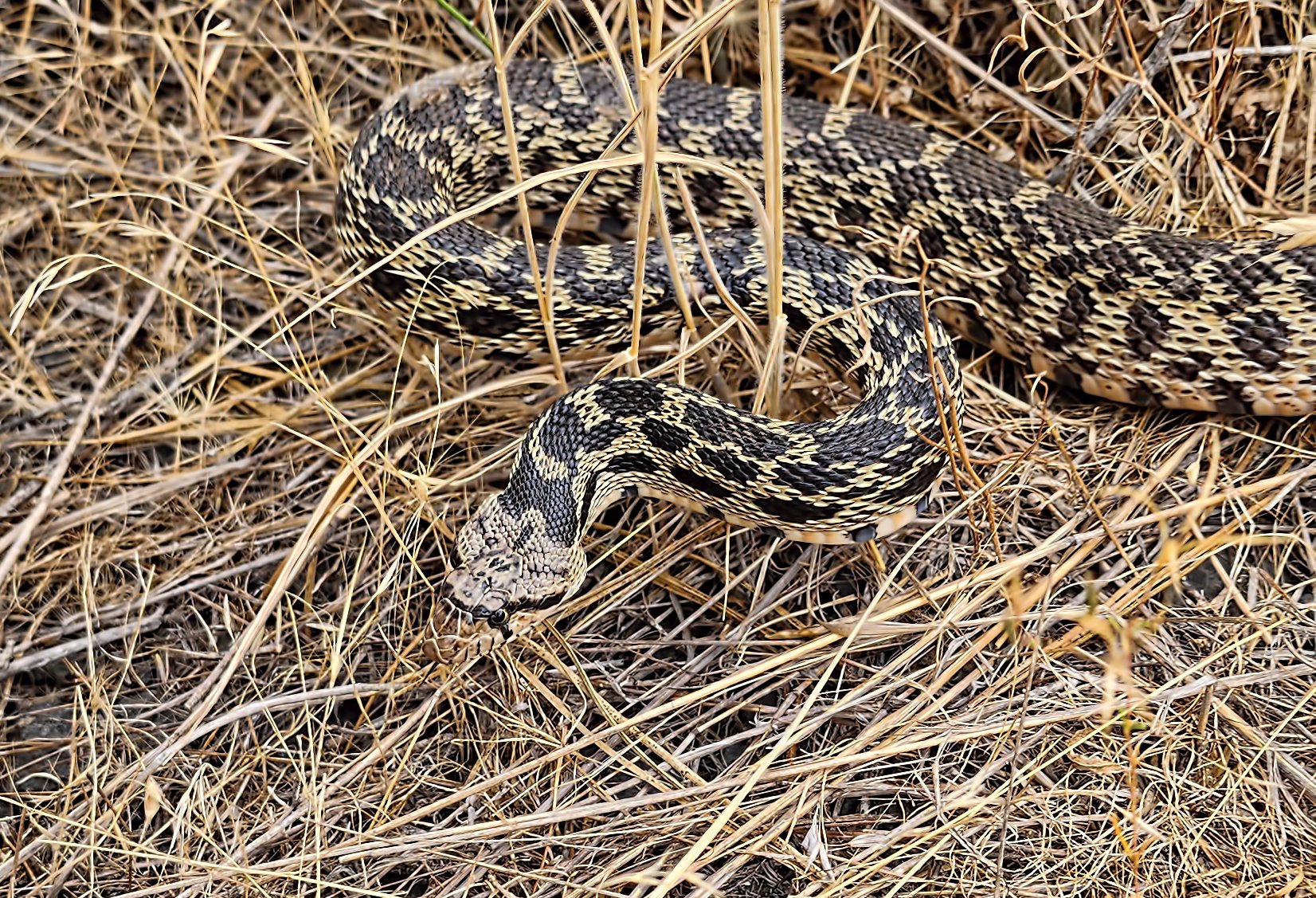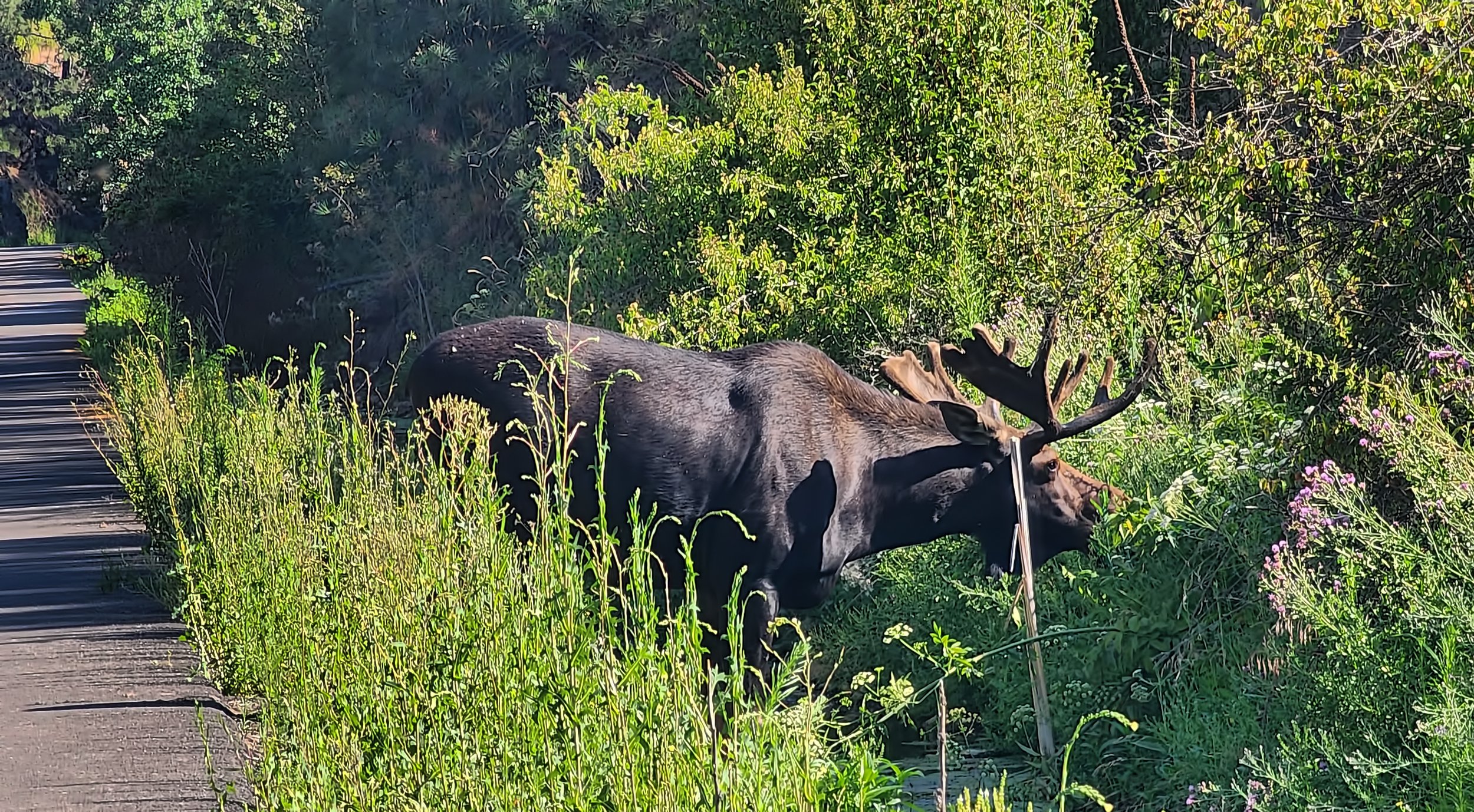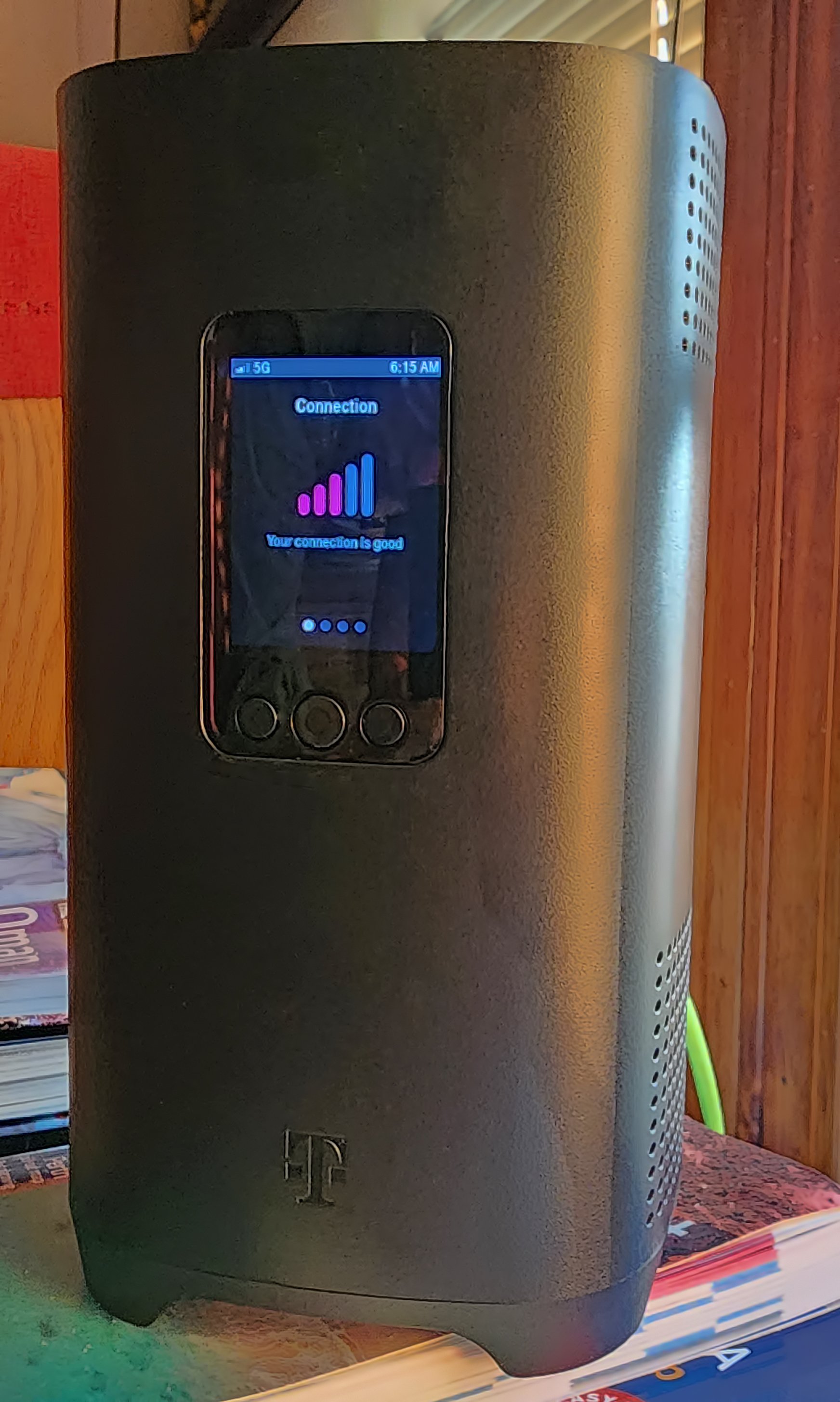at the leading edge of the wind driven wildfire. I estimate that only about 40 acres of ponderosa pine forest burned, thanks to the quick aerial response in dousing the fire.
A nicely camouflaged bullsnake...
hiding in the dry grass.
Bullsnake (Pituophis catenifer sayi).
Heroes in yellow shirts...
darkened by carbon black and soot are keeping a watchful presence on the recent nearby wildland fire, managing several pumps and a tangle of fire hoses. I thanked them profusely for their hard work on behalf of the local community. Fortunately rain is in the near forecast.
Cheerful fire crew from Eastside Fire and Rescue, Issaquah, Washington.
Walk your bike! Fish Lake Trail near Spokane, Washington.
Fire near the Fish Lake Trail...
flared up this evening east of town, likely due to sparks along the railroad, with local firefighters and aerial crews immediately attacking the fast spreading fire. I snapped these images with my smartyphone camera on the trail, then retreated for a wider view.
Four AT-802F Fire Boss aircraft attack the fire with several helicopters and a spotter plane in support.
The day after: Still smoldering pine duff at the southwestern edge of the fire margin. The trail is closed and crews are still on site.
This diminutive songbird...
is modeled in metal, but at a considerably larger scale.
Pygmy Nuthatch (Sitta pygmaea), both foreground and background.
Unsponsored plug: If you’re a bird lover, check out Metalbird.
Soaking up the remaining warmth...
of the asphalt surface of the bike trail, this smart reptile enjoys a few moments at sunset.
Common gartersnake (Thamnophis sirtalis).
Deer crossing ahead...
on the wildlife-rich Fish Lake Trail this morning.
Mule deer doe with two fawns (Odocoileus hemionus).
Fallen rock debris swept clear...
of the Fish Lake Trail by a crew from Washington State Parks, yet the hazard of rock topple still remains along this short stretch of passage.
Site in early July 2023, but the rockfall occurred during winter or spring.
Site today following cleanup of fallen debris on the trail. One leaning basalt column remains.
A soft, sedimentary interbed lies below the columnar-jointed basalt lava flow unit and is considerably more erodible. The excavation of the railroad cut in the early 20th century exposed the contact and this will likely have to be maintained in perpetuity. Trail users beware!
Duckling diving lessons...
were underway late this morning, with Minnie, the mamma Mallard, coaching on the sidelines.
Mallard Ducks (Anas platyrhynchos).
Look ma, got something!
Trying to get a turtle to smile...
for the camera is an absolutely impossible task.
A grumpy painted turtle (Chrysemys picta).
A preening cutie...
in the creek while Mom keeps a watchful eye nearby.
Mallard Duck chick (Anas platyrhynchos).
This is the mamma Mallard, named Minnie.
Yielding to Bullwinkle J. Moose...
on the Fish Lake Trail this morning! Huge and magnificent beast!
Bull moose (Alces alces).
These snaphots were made with my smartyphone camera from about 35 yards/meters away.
Meet the Mallards of Minnie Creek...
Mallard or Wild Duck (Anas platyrhynchos).
Happy duckling!
A determined muskrat...
carrying breakfast back to the family burrow early this morning along Minnie Creek. Quite amusing to observe as it calmly paddled by on its mission.
Muskrat (Ondatra zibethicus).
Luminous fireweed catching first light...
early this morning. Its blooms slowly march up the tall stem through the summer, reaching the apex as the first frost approaches. Looks like we have a while to go.
Fireweed (Chamaenerion angustifolium), also known as great willowherb north of the border.
A clever and simple early warning system...
was in use by the operators of the Spokane, Portland and Seattle Railway Company in the early 1900s to guard against rockfalls spilling onto the tracks and causing an accident. A series of electrified wires were strung along the more unstable sections of the rock cuts in the columnar basalts that are prone to toppling. Should the circuit be cut it would potentially indicate that a rock had severed the wire. Some relics of this system remain along the paved trail in the form of standing poles, some with insulators. The line was abandoned by the railroad in 1987 and eventually incorporated into the Columbia Plateau State Park Trail.
Location of a recent rockfall onto the paved trail. The vertical spacing of the insulators suggests a series of parallel wires, strung pole to pole, along the length of a cut.
Evolving wireless broadband technology...
has enabled a faster and more reliable connection to the Internet from my rural residence in eastern Washington. I can highly recommend T-Mobile’s 5G Wi-Fi Gateway device if it is available in your area, where I am enjoying two orders of magnitude increase in both upload and download speeds over my previous provider. And at only $50/month (with no contract and no data caps) it’s half the cost of my previously lousy service. Zoom zoom!
Typical results of a speed test with the new T-Mobile 5G device on my home network.
A pleasant paddle...
was had by all on a lovely and calm morning, captured on my ritual early morning ride.
Female Mallard Duck (Anas platyrhynchos) and juveniles, this image and below.
Infinite shades of green...
are present in the verdant and water-saturated wetlands in eastern Washington, a welcome relief to the red tones burned deep into my retinas after spending months in arid red rock country.
The easily recognizable American Robin...
is the most abundant landbird in North America with an estimated population of 370 million individuals. Here’s just one.
American Robin (Turdus migratorius).


































